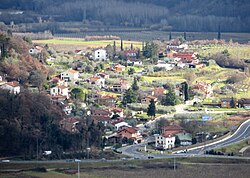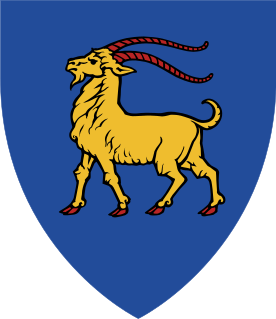
Istria, formerly Histria (Latin), Ίστρια, is the largest peninsula in the Adriatic Sea. The peninsula is located at the head of the Adriatic between the Gulf of Trieste and the Kvarner Gulf. It is shared by three countries: Croatia, Slovenia, and Italy. Croatia encapsulates most of the Istrian peninsula with its Istria County.
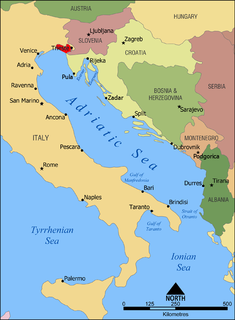
The Gulf of Trieste is a very shallow bay of the Adriatic Sea, in the extreme northern part of the Adriatic Sea. It is part of the Gulf of Venice and is shared by Italy, Slovenia and Croatia. It is closed to the south by the peninsula of Istria, the largest peninsula in the Adriatic Sea, shared between Croatia and Slovenia. The entire Slovenian sea is part of the Gulf of Trieste.

The Gulf of Venice is a gulf that borders modern-day Italy, Slovenia and Croatia, and is at the north of the Adriatic Sea between the delta of the Po river in Northern Italy and the Istria peninsula in Croatia.
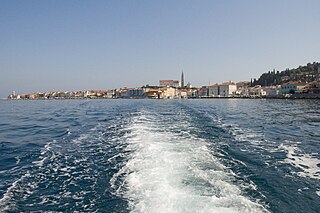
The Gulf of Piran or Piran Bay is located in the northern part of the Adriatic Sea, and is a part of the southernmost tip of the Gulf of Trieste.

The A9 motorway is a north–south motorway in Croatia, with a length of 78.3 kilometres. Beginning in Pula, the largest city on the Istrian peninsula, it runs north to the Croatian motorway and expressway network at the Kanfanar interchange. Here it meets the A8 motorway, forming the Istrian Y road system. The A9 continues north from here to the Kaštel and Plovanija border crossings into Slovenia. The motorway represents a significant north–south transportation corridor in Croatia and is a part of the European route E751. The motorway's national significance is reflected in the positive economic impact on the cities and towns it connects, as well as its importance to tourism in Croatia. Importance of the motorway for tourism is particularly high during summer tourist seasons, when traffic volume increases by more than 80%.

The European route E751, or E751, as defined by the Declaration on the Construction of Main International Traffic Arteries of 1975, and subsequent documents which amended the treaty, is an east-west Class-B branching European road route. Originating in Rijeka, Croatia, where it diverges from European route E61 before passing through the Kanfanar interchange, the route connects Pula, Rovinj, Poreč and Umag in Croatia with Koper in Slovenia. The route provides a high-performance road link in Istria and Slovenian Littoral. Unlike most routes, the E751 centers on the Kanfanar interchange and has three arms, each extending to Rijeka, Pula and Koper. The total length of the route, including all the route arms, is 160 km (99 mi).

The Dragonja is a 30-kilometre (19 mi) long river in the northern part of the Istrian peninsula. It is a meandering river with a very branched basin and a small quantity of water. It has the pluvial regime and often dries up in summer. It features very diverse living environments and is home to a number of animal and plant species. The Dragonja has been a matter of a territorial dispute between Croatia and Slovenia, with its lowest portion de facto the border of the two countries.
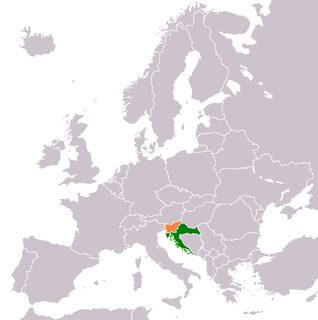
Croatia–Slovenia relations are foreign relations between Croatia and Slovenia. Croatia has an embassy in Ljubljana and two honorary consulates in Maribor and Koper. Slovenia has an embassy in Zagreb and an honorary consulate in Split. The countries share 670 km (420 mi) of common border. Relations between Slovenia and Croatia are generally considered to be friendly, but plagued with a series of unresolved border disputes and other vestiges from the time when both countries were the northernmost part of SFR Yugoslavia.

Obrežje is a settlement in the Municipality of Brežice in eastern Slovenia, close to the border with Croatia. The area was traditionally part of Lower Carniola. It is now included with the rest of the municipality in the Lower Sava Statistical Region.

Nova Vas nad Dragonjo is a village to the northeast above Dragonja in the Municipality of Piran in the Littoral region of Slovenia.

Sečovlje is a settlement in the Municipality of Piran in the Littoral region of Slovenia.

Following the breakup of Yugoslavia in 1991, Slovenia and Croatia became independent countries. As the border between the countries had not been determined in detail prior to independence, several parts of the border were disputed, both on land and at the sea, namely in the Gulf of Piran.

The highways in Slovenia are the central state roads in Slovenia and are divided into motorways and expressways. Motorways are dual carriageways with a speed limit of 130 kilometres per hour (81 mph). They have white-on-green road signs as in Italy, Croatia and other countries nearby. Expressways are secondary roads, also dual carriageways, but without an emergency lane. They have a speed limit of 110 kilometres per hour (68 mph) and have white-on-blue road signs.
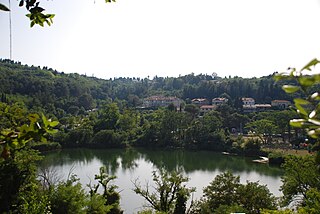
Fiesa is a street in Portorož, a settlement in the Municipality of Piran. It mainly lies in a small plain next to Fiesa Bay west of Strunjan and southeast of Piran. The beachfront west and east of the central part has high cliffs. It is connected with Piran by a road through the hills and a beach promenade along the northern beachfront. There are two hotels, a few guesthouses, and a camping site in Fiesa.

D21 is a 80.1-kilometre-long (49.8 mi), north–south state road in Istria County, Croatia. A short section of D21 is a part of the European route E751. The northern terminus of the route is located at the Croatia–Slovenia border at the Dragonja River. There it connects to Koper, Slovenia, and Trieste, Italy, via the Slovene route G11 further north. D21 route is generally parallel to A9 motorway. The two form several junctions, either directly or via short connectors, at Buje, Bale and Vodnjan – towns served directly by D21. The southern terminus of the route is found in the city of Pula, at the southern tip of the Istrian Peninsula.

Slovene Istria is a region in southwest of Slovenia. It comprises the northern part of the Istrian peninsula, and it is part of the wider geographical-historical region known as the Slovene Littoral (Primorska). Its largest urban center is Koper. Other large settlements are Izola, Piran and Portorož. The whole region has around 120 settlements. In its coastal area, both the Slovene and Italian languages are official.

The Sečovlje Saltworks is the largest Slovenian salt evaporation pond. Along with the Strunjan Saltworks, they are the northernmost Mediterranean saltworks and one of the few where salt is still produced in a traditional way, as well as a wetland of international importance and a breeding place for waterbirds. They are part of the Piran Saltworks and are located at Parecag in Slovenian Istria, the southwest of the country, at the Adriatic Sea, along the mouth of the Dragonja River near Sečovlje.

The Slovene Riviera is the coastline of Slovenia, located on the Gulf of Trieste, by the Adriatic Sea. It is part of the Istrian peninsula and is 46.6 km long. The region comprises the towns of Koper and Piran with Portorož, and the municipality of Izola. It is a seaside tourist destination, with a vibrant multiethnic Slovenian and Italian heritage.

The Gulf of Koper or Koper Bay is located in the northern part of the Adriatic Sea, and is a part of the Gulf of Trieste.
